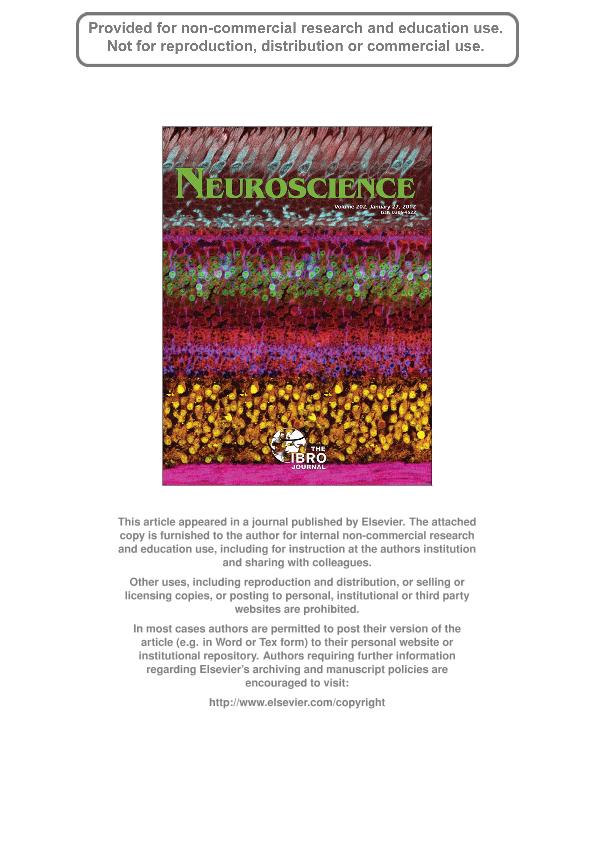Mostrar el registro sencillo del ítem
dc.contributor.author
Pietrelli, Adriana
dc.contributor.author
López, Juan José

dc.contributor.author
Goñi, Ricardo
dc.contributor.author
Brusco, Herminia Alicia

dc.contributor.author
Basso, Nidia

dc.date.available
2019-01-04T13:38:47Z
dc.date.issued
2012-01
dc.identifier.citation
Pietrelli, Adriana; López, Juan José; Goñi, Ricardo; Brusco, Herminia Alicia; Basso, Nidia; Aerobic exercise prevents age-dependent cognitive decline and reduces anxiety-related behaviors in middle-aged and old rats; Pergamon-Elsevier Science Ltd; Neuroscience; 202; 1-2012; 252-266
dc.identifier.issn
0306-4522
dc.identifier.uri
http://hdl.handle.net/11336/67383
dc.description.abstract
Recent research involving human and animals has shown that aerobic exercise of moderate intensity produces the greatest benefit on brain health and behavior. In this study we investigated the effects on cognitive function and anxiety-related behavior in rats at different ages of aerobic exercise, performed regularly throughout life. We designed an aerobic training program with the treadmill running following the basic principles of human training, and assuming that rats have the same physiological adaptations. The intensity was gradually adjusted to the fitness level and age, and maintained at 60-70% of maximum oxygen consumption (max.VO 2). In middle age (8 months) and old age (18 months), we studied the cognitive response with the radial maze (RM), and anxiety-related behaviors with the open field (OF) and the elevated plus maze (EPM). Aerobically trained (AT) rats had a higher cognitive performance measured in the RM, showing that exercise had a cumulative and amplifier effect on memory and learning. The analysis of age and exercise revealed that the effects of aerobic exercise were modulated by age. Middle-aged AT rats were the most successful animals; however, the old AT rats met the criteria more often than the middle-aged sedentary controls (SC), indicating that exercise could reverse the negative effects of sedentary life, partially restore the cognitive function, and protect against the deleterious effects of aging. The results in the OF and EPM showed a significant decrease in key indicators of anxiety, revealing that age affected most of the analyzed variables, and that exercise had a prominent anxiolytic effect, particularly strong in old age. In conclusion, our results indicated that regular and chronic aerobic exercise has time and dose-dependent, neuroprotective and restorative effects on physiological brain aging, and reduces anxiety-related behaviors. © 2011 IBRO.
dc.format
application/pdf
dc.language.iso
eng
dc.publisher
Pergamon-Elsevier Science Ltd

dc.rights
info:eu-repo/semantics/openAccess
dc.rights.uri
https://creativecommons.org/licenses/by-nc-sa/2.5/ar/
dc.subject
Aging
dc.subject
Anxiety
dc.subject
Exercise
dc.subject
Learning
dc.subject
Memory
dc.subject
Stress
dc.subject.classification
Otras Ciencias de la Salud

dc.subject.classification
Ciencias de la Salud

dc.subject.classification
CIENCIAS MÉDICAS Y DE LA SALUD

dc.title
Aerobic exercise prevents age-dependent cognitive decline and reduces anxiety-related behaviors in middle-aged and old rats
dc.type
info:eu-repo/semantics/article
dc.type
info:ar-repo/semantics/artículo
dc.type
info:eu-repo/semantics/publishedVersion
dc.date.updated
2019-01-02T19:42:00Z
dc.journal.volume
202
dc.journal.pagination
252-266
dc.journal.pais
Estados Unidos

dc.journal.ciudad
Nueva York
dc.description.fil
Fil: Pietrelli, Adriana. Consejo Nacional de Investigaciones Científicas y Técnicas. Oficina de Coordinación Administrativa Houssay. Instituto de Biología Celular y Neurociencia "Prof. Eduardo de Robertis". Universidad de Buenos Aires. Facultad de Medicina. Instituto de Biología Celular y Neurociencia; Argentina. Universidad de Ciencias Empresariales y Sociales; Argentina
dc.description.fil
Fil: López, Juan José. Consejo Nacional de Investigaciones Científicas y Técnicas. Oficina de Coordinación Administrativa Houssay. Instituto de Biología Celular y Neurociencia "Prof. Eduardo de Robertis". Universidad de Buenos Aires. Facultad de Medicina. Instituto de Biología Celular y Neurociencia; Argentina
dc.description.fil
Fil: Goñi, Ricardo. Universidad de Ciencias Empresariales y Sociales; Argentina
dc.description.fil
Fil: Brusco, Herminia Alicia. Consejo Nacional de Investigaciones Científicas y Técnicas. Oficina de Coordinación Administrativa Houssay. Instituto de Biología Celular y Neurociencia "Prof. Eduardo de Robertis". Universidad de Buenos Aires. Facultad de Medicina. Instituto de Biología Celular y Neurociencia; Argentina
dc.description.fil
Fil: Basso, Nidia. Consejo Nacional de Investigaciones Científicas y Técnicas; Argentina. Universidad de Ciencias Empresariales y Sociales; Argentina. Universidad de Buenos Aires. Facultad de Medicina. Instituto de Fisiopatología Cardiovascular; Argentina
dc.journal.title
Neuroscience

dc.relation.alternativeid
info:eu-repo/semantics/altIdentifier/url/https://www.sciencedirect.com/science/article/pii/S0306452211013418
dc.relation.alternativeid
info:eu-repo/semantics/altIdentifier/doi/https://doi.org/10.1016/j.neuroscience.2011.11.054
Archivos asociados
